Astronomical Almanac’s Algorithm Based Dual Axis Solar Tracker
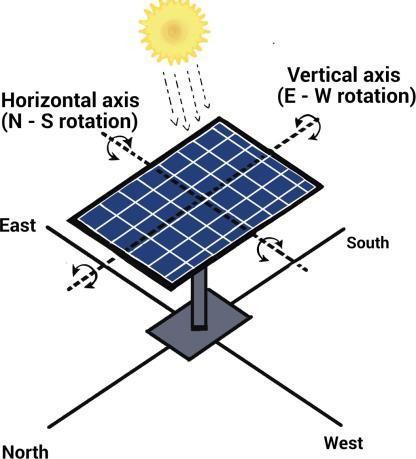
Abstract The main problem presently is fossil energyex haustion; Due to widespread use, nonrenewable energy sources such as petroleum and coal are fast decreasing. Solar energy is sun derived energy that is environmentally friendly, a renewable energy source that produces no pollution, requires no upkeep, and is completely free. This paper offers the method for sun tracking by using a dual axis solar tracking system thatuses the latest sun tracking Astronomical Almanac (AA) algorithm. The hardware is divided into two modules the weather station and the solar tracking panel area. A weather station is integrated with the system so as to provide users with real time access to data, allowing them to adapt to the changing weather conditions by tilting the panel axis towards solar energy. The presented design shall be connected to an application permitting the user to access and view the data.
1.INTRODUCTION
Solarenergy is currently gaininga lot ofattentionas apromisingrenewableenergysource.Renewableenergy sources can be used to overcome the energy crisis generated due to the maximum use of Fossil fuel resources[1]. If the use of fossil fuels continues at the samerate,itwillleadtoitsextinction in the near future.

It is possible to use solar energy, wind energy, rainfall, and other renewable resources. Solar energyis free and can be collected with the use of solar panels, solar power is one of the most widely used alternative pathways in renewableenergysources. Solar panels are essentially light to electricity converters. Trackers are utilised in these systems to help reduce the angle of incidence. i.e. between the incoming light and the panel, the angle formed by a beam of light with a line perpendicular to the surface, which increases the quantityofenergy[4].
Allsolarpanelsystemsfeaturetrackerssincethepanels can’t create energy unless they’re pointed in the right direction. Trackers are classified as either single axisor dual axis. Single axis trackers typically move in regular intervals to compensate for angular position,whereas dual axissystemtrackersalsomoveinregularintervals tocompensateforangularposition.Themajordifference is while single axis can move in only one particular direction, dual axis trackers can move in all four directions, including north, east, west, and south,
allowing them to collect the most energy from the sun.[1].
Fig 1: Solartrackeraxisdesign
The more light the solar cell receives, the more power it generates. The efficiency of most of the solar trackers is around 10 15 %, as these trackers mainly depend on LDR(Light Dependent Resistor)[5]. ].In solar trackers, LDRs are basically used to detect the light levels and track sunmovement by placing them in the four corners of thePV panel. LDR based systems alone might be insufficient to achieve the required performance of the tracker[5]. The required angle for tracking is not accurateandtheerrorrateishigh.Dueto thesemanyreasons, it is not a good choice to choose an LDR basedsystem.Hence,theinaccuracycausedbythe LDR based system can be worked upon by using algorithm basedcontrolsystems.Theycanfurther make thesystemmoreintelligentbyintroducingpredictionsof sunmovement.Byusingthesun trackingalgorithmour systemfocusesonincreasingefficiencyby30 40%[5].
Increasing the efficiency of the panel leads tomore power and more return on investment, producinggreater results. The size of the system, the rates, land limits, weather, feasibility, and other factors all influence the choice of a solar tracker. Horizontal single axis trackers are commonly used in large projects, whereas vertical trackers are idealfor high latitudes due to their fixed or adjustable angles. In simple home applications, dual axis trackersandsingle axistrackersarecommonlyused.
1,2,3,4 Student, St. Francis institute of technology 5Professor, St. Francis institute of technology
ISSN:2395 0056
Volume: 09 Issue: 06 | June 2022 www.irjet.net p ISSN:2395 0072

Itisvitalforthepaneltobedirectlyorientedtothesun at all times in order to maximise powergeneration and system efficiency. To do so, our system introduces an algorithmic approach to align the panel towards the sun positionautomati cally.Youcanalsomanuallymovethe panel using the system’s controls. The weather station integrated with our system sends a signal to the system oncecloudyorovercastconditionsgetdetected,tiltingthe panel in perpendicular orientation. A solar tracker system can be made more efficient in one of three ways. The first technique is to raise the efficiency ofelectricity generation, while the second is to improve control algorithmefficiency,thethirdwayistouseasolar energy maximizing tracking system. Thisproject’s purpose is to combine the second and third methods for increasing efficiency.
2. SYSTEM DESIGN
2.1 Structure of solar tracker system
This study demonstrates how to use a basic and low costInternetofThingsstrategytooverseeand regulate a smart dual axis solar tracker system. Our system showcases that maximum power is generated automatically,asthetrackerkeepstrackingtheposition ofthesun.Figure2depictsthestructureof oursystem. The main elements of our system are thetrackingunit, positioningunit,manualcontrolsystem,sensors,andIoT application.HerethesystemusesESP32asacontrolunit that manages theservomotorsand sends signals to the system. Foursolarplates of4volts each, generating 6v 60 mAh output are connected to two SG90 servo motors. These servo motors are used for the vertical andhorizontalmovementofthepanelandprovideease inrotationand tilt movementof the panel.
Fig 2: Solartracker
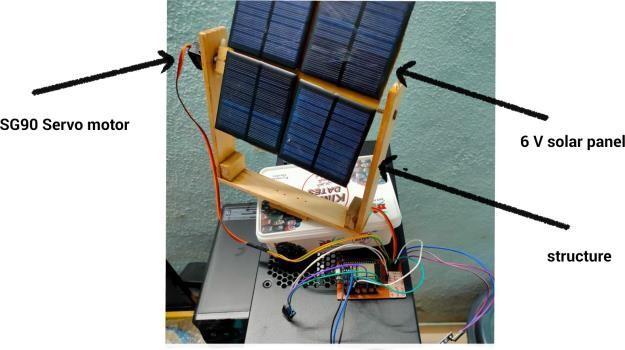
Fig 3: Weatherstation
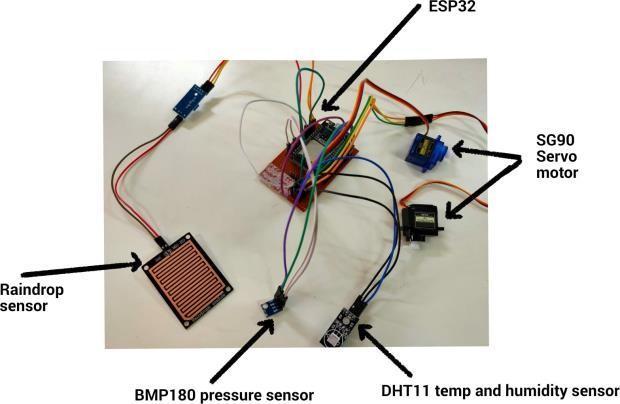
A raindrop sensor, which monitors moisture, is partof a weather station. A BMP180 digital barometric pressure sensor is used to take note of the change in speed of wind or altitude. The DHT11 sensor is a popular and inexpensive sensor. It uses a capacitive humidity sensor and a thermistor to monitor the environment. All these sensors are connected to ESP32. The primary purpose of weather sensors is to provide data on current weather conditions. An IoT application called Cayenne is used to monitor and keep track of theoutputdatageneratedbythe sensors. Cayenne employsthe Message Queuing Telemetry Transport (MQTT) protocol. To communicate with the Cayenne cloud, youmust utilise the MQTT protocol. The dual axissolartrackercanrotateandshiftautomaticallyin orderto track thesun’slocationaccording toanalgorithm, or can also be manually handled by the user through this IoT application.
2.2 WORKING MECHANISM
Firstly, the system detects the sun’s position by the algorithm and sends data to the controller (ESP32). The programmecalculatestheazimuthandelevationangleofthe sun given latitude, longitude, date, and time. Based on the values derived from the algorithm the panel position gets set. This information is processed bythe controller, which then sends commands to the servomotors (S1 and S2) to spin the panel towards the sun. The left right (L R)servo motor rotates the solar tracker on the vertical axis (East/West), while the up down(U D)servo motorrotates the solar tracker on thehorizontal axis (South/North).The datafromthesolar tracker,suchastemperature,humidity, andrainfall,isdisplayedin real time by the IoT monitoring app.
The IoT monitoring application was built using the Cayenne my Devices platform. Cayenne connects any device to the Cayenne cloud via the MQTT protocol. Once linked to the network via a smartphone or computer, the user can analyse all of the statistics in theIoT application. The solar tracking system has two modes of operation: manualandautomatic.Abuttononthe Cayenne dashboard
International Research Journal of Engineering and Technology (IRJET) e ISSN:2395 0056

Volume: 09 Issue: 06 | June 2022 www.irjet.net p ISSN:2395 0072
is being used to toggle between both two modes. When not in use, the manualmode is chosen; alternatively, the algorithmicmodei.e.automaticmodeisopted.Asaresult, the user has allof the necessary information about the environment and the performance of the PV panel. Furthermore, when the manual option is activated, the usercansimplycontroltheservomotorpositionstoorient the PV panel from east to west using the L R servomotor or from south to north using the U Dservomotor. If the automatic mode is chosen, the algorithmwillberun.Asa result, the user can operatethe system to obtain precise environmentalconditionsand collect the greatest amount ofenergyfromthePV panel.
compute the output. The algorithm determines the solar azimuth and elevation angles of the sun. Using these angles, the solar panel is then oriented toward the sun. TheAAalgorithmtakesmanyfactorsintoaccount.Various inputs such as year, day, time, latitude,and longitude are given to get the output parameters sun azimuth angle, sunelevationangle.
In order to understand the working of the Astronomical Almanac’s algorithm, We must first understand the terms used in the algorithm thattracks thesun’smovement.
A. Time
The time input in our algorithm specifies the gap between the observed Julian date and JDate- 2451545, whichrepresentsJanuary1,2000.
JDate=JulianDate(year,month,day);
B. Declination
Fig 4 :Workingmechanismofthe system
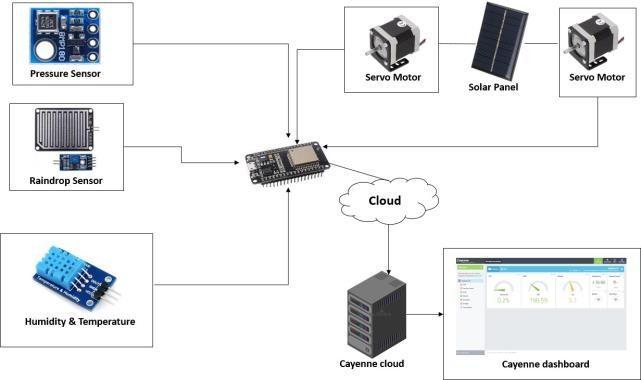
Moreover, the data collected from weather sensors is usefultodetectovercastorrainyweatherconditions.The tracker is programmed to automatically orient the panel perpendicular to the sun when such conditions are detected, as research proves it to be the most efficient position in case of such scenarios.
Though the energy collected shall be less compared to normalsunnydays.
3. ASTRONOMICAL ALMANAC’S ALGORITHM
TheAstronomicalAlmanac’salgorithmorsimply sayingthe AA algorithm has been implemented in our system. Our algorithm is used to identify or determine the position or location of sun at any time, any day of a specific geographical location. The sun’s position is affected by the rotation of the earth, hence the sun’s positionisdependentontheacquireddate,time,location latitude,andlongitude.Thesolarpositionandthemost suitable tilt of the panel towardsthe sun are calculated using this method, which changes throughout the day. One of the factors through which you can improve the solar tracker efficiency and reduce its error rate is by implementing an algorithm that tracks every movement of the sun and can generate up to 20 30% of more energy than that of a regular LDR based system. The methodisusedbecauseofitseasiness,serviceability,and abilitytorapidlytakeintoaccountthesolarposition and
The sun’s declination is the angle formed by the equator andalinedrawnfromtheEarth’scentretothe sun’s centre. The tilt of the Earth on its axis of rotation aroundthesuncausesthisangletochange.Thefollowing formulaisusedtocomputethedeclinationangle:
Sin(sin(Obl)* sin(L_true)) Where, Obl(oblinquity of ecliptic) (eplipticlong)
C. Right ascension
Ascension to the right Right ascension (RA) and declination (DEC) are to the sky what longitude and latitude are to the Earth’s surface. The east/west direction (like longitude) is rep- resented by RA, while the north/south direction is represented by Dec. (like latitude).
The following formula can be used to computethe RA:sin(Ltrue)*cos(Obl),cos(Ltrue)
D. Hour Angle
AngleoftheHour,theazimuthandelevationofthesun arecalculatedusinganhourangle,declinationangle,and right ascension.
DEGTORAD*GrHrAngle+Lon-RA; where,
RA(Rightascension) Lon(longitude)
Volume: 09 Issue: 06 | June 2022 www.irjet.net p ISSN:2395 0072

Fig 5: Solaranglevariation
E. Solarazimuthangle
The azimuth angle indicates the compass directionthe sunlight is coming from. The azimuth angle changes duringthedayandcanbedeterminedusingthe following formula:
azimuth = PI + atan2(sin(HrAngle), cos(HrAngle)*sin(Lat) tan(Decl)*cos(Lat))
F. Solarelevation angle
Whenthesunisdirectlyoverhead,theelevationangle is 0degrees atsunriseand 90 degrees atsunset.It’sthe complement of the zenith, the angle between the horizontal planeand thesun’scentre ray.Th eelevation angle is the distance between thehorizontal plane and the angular height of the sun inthe sky. The following formulacanbeusedtocomputetheelevationangle, elevation=sin(Lat)*sin(Decl)+cos(Lat)*(cos(Decl) *cos(HrAngle))
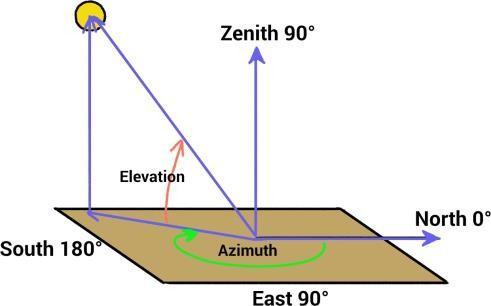
where, HrAngle(hour angle) Lat(latitude) Decl(declination)
Our solar tracker by default is set in automatic mode andwillbeusingthealgorithmembeddedinESP32.The initial position of our solar panel is 0 degree azimuth andwillorientaccordingtotheinputparameterssupplied
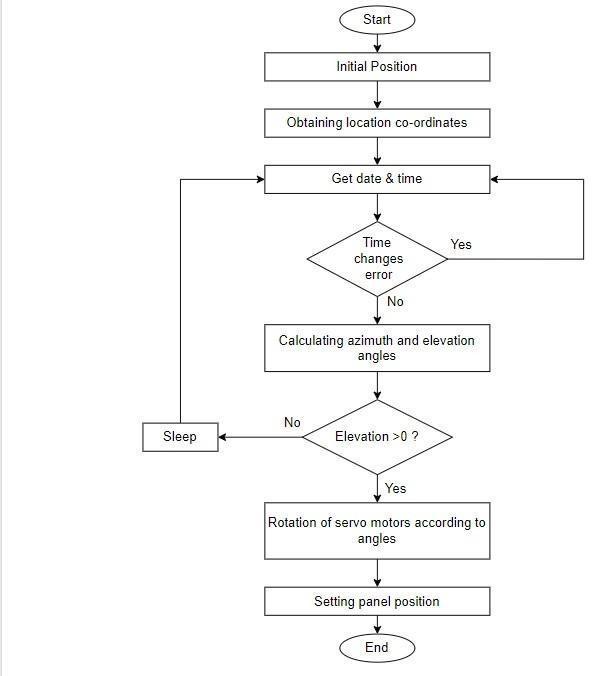
Fig 6: FlowchartofAAalgorithm
TheWifiSSIDandpasswordissetupintocodealong with the latitude and longitude to get the currentdate andtime.Next,thetimezonewassettoIST-5:30sothat ouralgorithmworksonthebasisofthelocaltime.
The Network Time Protocol (NTP) server, namely 0.uk.pool.ntp.org is used to synchronize the clocks between computers, devices, and networks over the Internet. If the system fails to acquire the time information, then it keeps on repeating the process till itreceivestheappropriatedata.Time acquiredisinthe HH:MM:SSformatalongwith day,month, and year. The sun’s azimuth and elevation angle are calculated using theinputparameters,andthe signal is then supplied to theservomotor.Theservomotorissetintomotionand sets the panel inthe appropriate position.These servo motors tiltthepanel in the desired position. The panel tilts a minimum from 0 degrees to a maximum of 180 degrees.
Once the servo motors rotate the panel up to a certain degree the setting of panel position is completed.
4. SOFTWARE DESIGN
A. Arduino IDE
The Arduino Integrated Development Environment, or Ar- duino IDE, is a platform for writing code that includes com- mon functions and other features. It connectstotheArduinohardware,allowing it to upload
International Research Journal of Engineering and Technology (IRJET) e ISSN:2395 0056

Volume: 09 Issue: 06 | June 2022 www.irjet.net p ISSN:2395 0072
and communicate with pro- grammes. It is compatible with the C and C++ programming languages. The controller in this project is programmed using an IDE, which allows users to alter codes before uploading them to the microcontrollerthroughaUSBwire.
B. Mydevicescayenne
myDevices is a company that specialises in Internet ofThings(IoT)solutions.Itprovides anend-to-end IoT platform. Cayenne was employed as an IoT application in our project. Cayenne connects any device to the Cayenne cloud via the MQTT protocol. Data can be transferredand received from the deviceto the system and vice versa once the connection is established. Various libraries, such as the CayenneMQTT library, were installed in the IDE using the library manager in order to use the MQTTprotocol. Information such as ClientID, password, and username were required to establishauthentication.
There are two main modes in our system: auto and manual. To switch between the two modes, a switch button is added in the Cayenne IoT application. Our system operates in auto mode by default. When the buttonisactivethesystemshallautomaticallyswitchto manual modethusallowingtheuser tomanuallyhandle thetracker.Theusercancontrolthepanelpositionifthe manual option is selected. If the automatic mode is chosen,thealgorithmshowninFigure 6will beused.
5. RESULTS AND DISCUSSION
OurprototypesystemisdisplayedinFig.7TheESP32 is powered by a computer through a USB cable. With the IoT application, the Wifi establishes internet connectivity.Thedatafromthesolartrackersystem can be monitored once the connection with the IoT applicationis established
Fig 8: Environmentalmeasurements(Humidity)

Fig 7: Environmentalmeasurements(temperaure)
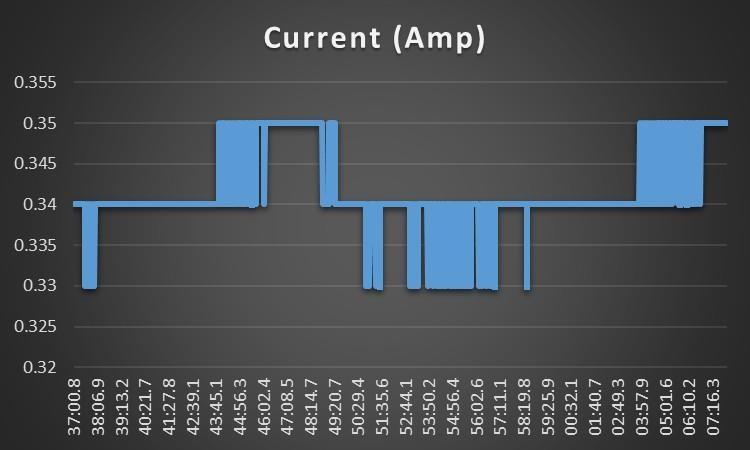

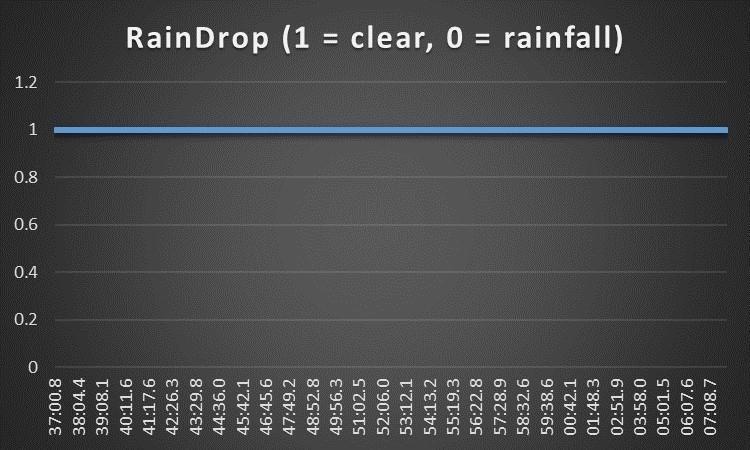
Fig 9: Environmentalmeasurements(Raindrop)
The real- time sensor information namely the temperature, humidity, pressure, and rainfall can be displayed in the IoT application. The auto mode is activated first and hence the servo motors are automaticallycontrolledthroughthealgorithm.Theservos willtiltandalignthepanelindirectionofthesunbasedon the angles calculated. When the servosare switched to manual mode, the widgets areusedto control them. The sliderislinkedtotheservomotorwhichwhenincreased ordecreasedpassesthedegreevalueandtiltsthepanelas perusergiven
input. This can save power as the panel can be positioned in one particular direction for an entire seasonsuchaswinter,or rainy.Thoughthisshall also reduce the PV energy generated due to the panel not beingabletomove.
Fig. 10: Environmentalmeasurements(Current)
Fig. 12:Environmentalmeasurements(Voltage)

InanIoTapplication,datasamplesarerecordedinreal time,tryingtoensurethatallenvironmentalandelectrical measurements are provided accurately. It has been developed to send an alert to test the monitoring application’s reliability. When an event occurs, the user is notified. When the measured temperature hits 40°C, for example, an alert notification is sent to our mailbox atthesamemomentascanbeseenin fig10
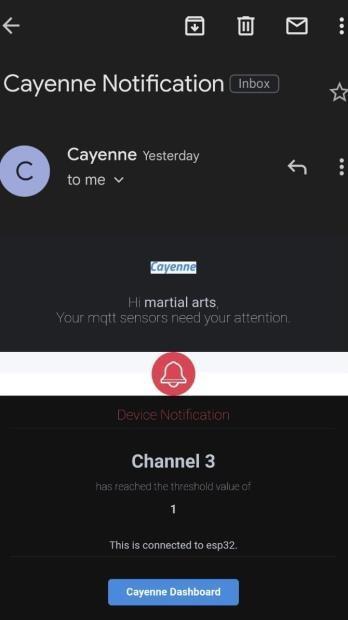
Fig 14: CayenneNotification
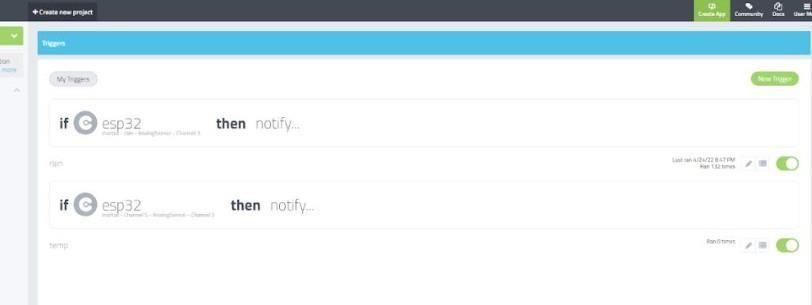

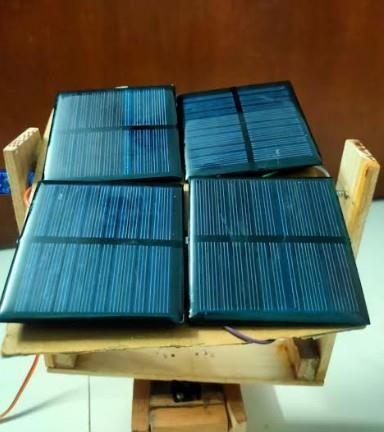
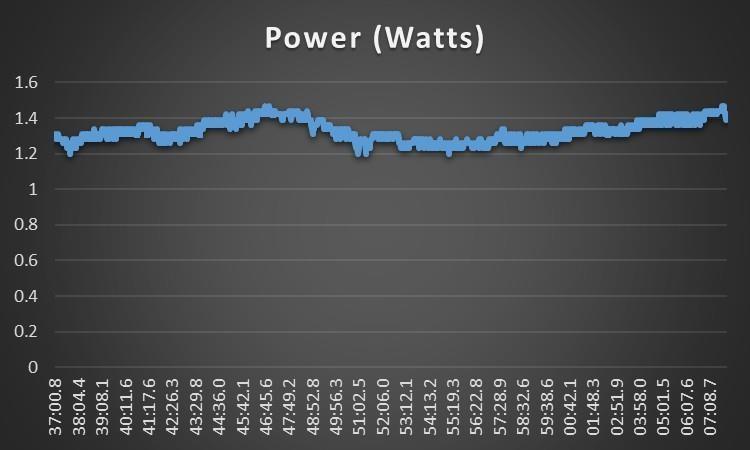
Other alarms, such as a sensor and/or actuator fault and a sudden drop in PV power, can be added tothe programme.
Similarlytherainfallismeasuredbasedonthethevalues 0 or 1, with 1 indicating the clear weather and 0 indicating the rainy weather condition. Furthermore, testing has shown that the solar tracker implements commands from the monitoring platform correctly and quickly, with a response timeof less than 2 seconds.In manual mode, the user can remotely position his device in an optimal direction based on the surrounding environment and device location. Furthermore, motor power consumption can be significantly reduced in this mode, or the user can intervene to direct the solar tracking system in only one direction for a particular seasonorperiod.
International Research Journal of Engineering and Technology (IRJET) e ISSN:2395 0056

Volume: 09 Issue: 06 | June 2022 www.irjet.net p ISSN:2395 0072
[3] V. Kumara, S. K. Raghuwanshib, “Design and Development of Dual Axis Solar Panel Tracking System for Normalized Performance En hancement of Solar Panel”, International Conference on Sustainable Computing in Science, Technology and ManagementFebruary 26 28, 2019.doi:10.2139/(SSRN).336308
[4] Rajshree,A.K.Jaiswal,C.Chaudhary,V.K.Jayswal, “Development of a Dual Axis Solar Tracking System Using LDR Sensor for Roof Top Applications”, Recent Trends in Sensor Research and Technology, vol. 3, no. 3, 2016.ISSN: 2393 8765
6. CONCLUSIONS
The proposed project is aimed at an efficientsolar panel system along with a mini weather station. To improvetheefficiencyofsuntracking,theAAalgorithm is applied. Ourtracker is dual axis,meaning it can track in both the X and Y axes. It moves left, right, up, and down, to put it even more simply. For accurate sun tracking, the AA Algorithmwasutilised.Thismeansthat after you’ve set up yourtracker, you’ll never have to updateortweakanythingbecauseitwillfollowthesun wherever it goes. This use of algorithm saves up to 20 30%
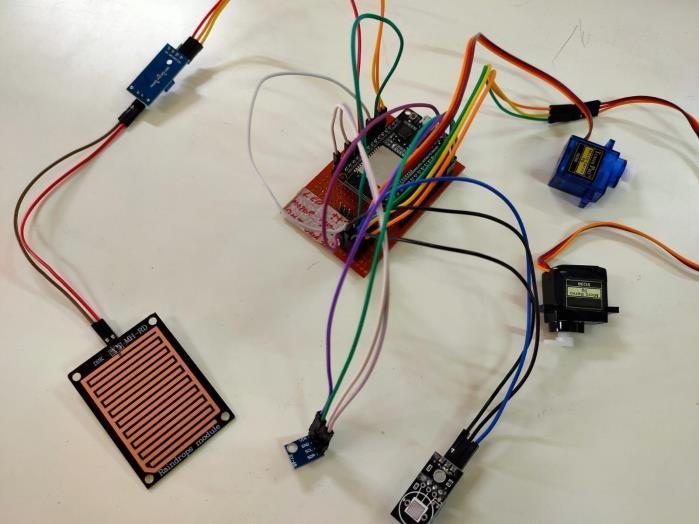
more power than regular LDR based systems. Our smart prototype can be used to monitor as well as control the tracker. TThe system can also be expanded to test the solar tracker’s flexibility in excessive pressure and high windy conditions. Due to its simplicity, reduced error rate, and cost effectiveness the proposed IoT solutions can be used in a variety of settings, including at home, in neighbourhoods, and in businesses
REFERENCES
[1] Fathy M. Mustafa and Seif A. Ahmed, “Design and Implementation of Dual Axis Solar Tracking System”,InternationalAdvancedResearchJournal in Science, Engineering and Technology. Vol. 4, Issue 11, November 2017. doi: 10.17148/IARJSET.2017.41103
[2] T.M. Thentral, M. Kannan, V. S. Mounika, M. Nair, ”Dual Axis Solar Tracker with Weather Sensor”, International Journal of Recent Technology and Engineering (IJRTE), Volume 8, Issue 2S11, September2019.ISSN:2277 3878
[5] M. E. H. Chowdhury, A. Khandakar,B. Hossain,R. Abouhaser, ”A Low Cost Closed Loop Solar Tracking System Based on the Sun Position Algorithm”, Hindawi Journal of Sensors, Volume 2019, Article ID 3681031.doi: 10.1155/2019/3681031.
Fig 16:Weatherstation